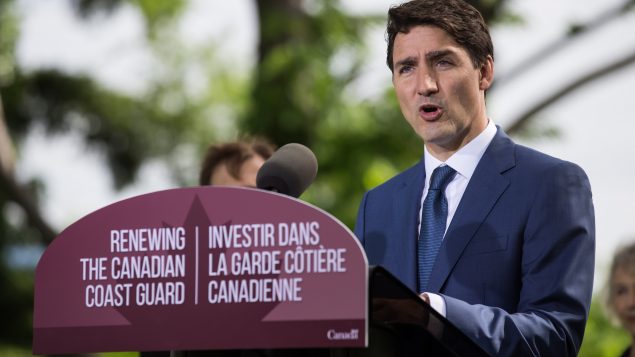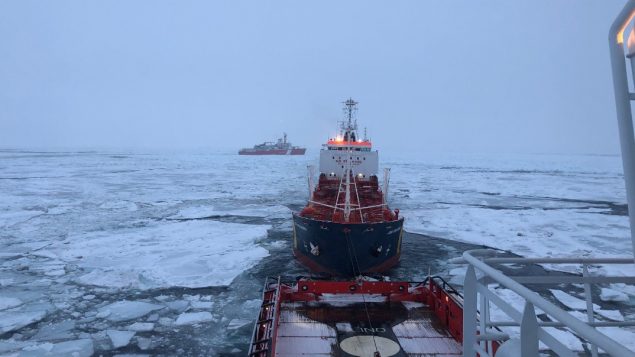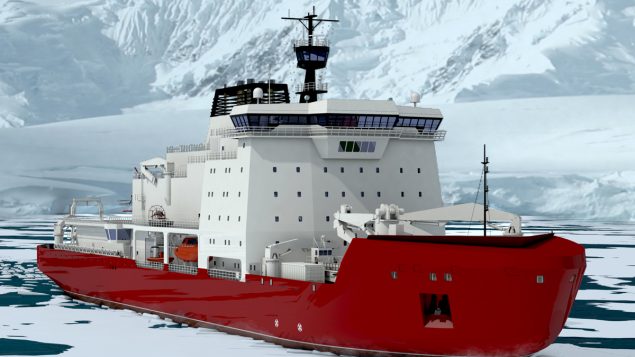The federal government intends to turn to another Canadian shipyard for the construction of its long-awaited polar ice breaker, according to officials at the Department of Fisheries and Oceans, which oversees the Canadian Coast Guard.
Under Canada’s National Shipbuilding Strategy, Seaspan’s Vancouver Shipyards and Irving Shipbuilding of Halifax had received the lion’s share of shipbuilding contracts for the Canadian Coast Guard and the Royal Canadian Navy.
That included the construction at Seaspan’s Vancouver Shipyards of the future polar icebreaker CCGS John G. Diefenbaker, named after Canada’s 13th prime minister.
However, given the importance of icebreaking capacity for Canada, Ottawa “is exploring other options to ensure the polar icebreaker is built in the most efficient manner, but no decisions have been taken,” said in an email to Radio Canada International Jocelyn Lubczuk, the press secretary of Fisheries and Oceans Minister Jonathan Wilkinson.
“To support future shipbuilding needs, and attract more talent and good jobs to communities through the country, the Government of Canada intends to add a third Canadian shipyard as a partner under the National Shipbuilding Strategy,” Lubczuk said.
Full order book for Seaspan and Irving

Prime Minister Justin Trudeau speaks after announcing the government plans to build up to 18 new coast guard ships, in Vancouver, on Wednesday May 22, 2019. (Darryl Dyck/THE CANADIAN PRESS)
Prime Minister Justin Trudeau announced in May that the federal government plans to spend $15.7 billion over the coming years to completely renew the coast guard’s ageing fleet and provide it with 18 new ships – 16 built by Seaspan’s Vancouver Shipyards and two civilian versions of the navy’s Arctic and Offshore Patrol Ship (AOPS) built by Irving Shipbuilding in Halifax.
- Ottawa commits to complete fleet renewal for Canada’s Coast Guard
- Ice-capable Canadian Coast Guard ships could be both ‘a blessing and a curse’: expert
The current work packages will keep both Irving Shipbuilding Inc. and Seaspan Vancouver Shipyards working to capacity until the late 2030s-2040s and their facilities cannot concurrently begin other construction projects, Lubczuk said.
“The government has pressing marine requirements and needs additional ships to be delivered in an earlier timeframe,” Lubczuk said.
“To help support these additional requirements, the Government of Canada is launching a competitive process to add a third Canadian shipyard as a strategic source of supply to help ensure the timely delivery of additional vessels to the federal fleet.”
With the construction of the two non-combat Joint Supply Ships (JSS) for the navy and the 16 Multi-Purpose Vessels (MPVs) for the coast guard, the federal government has essentially given Seaspan enough business to keep it busy for 20 years, Lubczuk said.
“Coast Guard’s future plans include the polar icebreaker to ensure continued delivery of its Arctic program,” Lubczuk said. “We have the design completed and are confident that when it is built, the new polar icebreaker will be a great addition to the fleet in support of Arctic sovereignty and northern science research.”
Officials at Seaspan could not be reached in time for publication.
Good news for Davie?

The Coast Guard icebreaker Terry Fox sits in the waters of Lancaster Sound, Nunavut at the eastern gates of the Northwest Passage in August 2006. (Bob Weber/THE CANADIAN PRESS)
Experts and industry insiders who spoke to Radio Canada International said they expected the contract for the construction of the future polar icebreaker to go to the Davie Shipyard in Quebec.
While making the announcement on the construction of 18 new ships for the coast guard, Trudeau also alluded to the fact that the workload at Seaspan’s Vancouver Shipyard and Irving’s Halifax Shipyard is “an opportunity for Davie to apply to become that third shipbuilding facility.”
Frédérik Boisvert, vice-president of public affairs at Davie, said the company has not heard anything official from Ottawa regarding changes in the government’s plans for the construction of a heavy polar icebreaker.
“However, it’s no secret that we’ve got a tremendous expertise in building ships on time and on budget but especially, we’ve got a real expertise in building icebreakers,” Boisvert said.
“In 2013, we made an unsolicited proposal to build Canada’s future polar icebreakers because everyone within the industry was aware that it could not be achieved under the original National Shipbuilding Procurement Strategy,” Boisvert added.
If the government had accepted it back then, Canada would already have a new polar icebreaker, he said.
Refitting medium icebreakers for the Coast Guard

Canadian Coast Guard icebreaker CCGS Captain Molly Kool tows tanker Jana Desgagnes in Cabot Strait. In the background the CCGS Louis S St-Laurent is assisting with the difficult ice conditions by breaking a large field of ice so that the vessels can manoeuvre. (Photo courtesy of the Canadian Coast Guard)
“Obviously, as the third shipyard of the National Shipbuilding Strategy we’re willing to partner with the government on whatever key projects they want us to be involved in,” Boisvert said.
Last year, Davie signed a $610-million contract with the federal government to acquire and convert three medium icebreakers to renew the Canadian Coast Guard’s ageing fleet.
These icebreakers will carry out icebreaking duties in Atlantic Canada, the St. Lawrence and the Great Lakes and Arctic regions.
One of these icebreakers, CCGS Captain Molly Kool, was delivered to the coast guard in December of 2018, the two remaining icebreakers will be delivered in late 2019 and early 2020, Boisvert said.
“But it’s far from over, Canada needs to renew its entire fleet of icebreakers,” he said.
“As well as the polar icebreakers (of which two are required), there are approximately 10 other medium and heavy icebreakers required by the Canadian Coast Guard which are not included in the existing umbrella agreements and we believe these ships will be included in Davie’s Large Ship Package.”
Timothy Choi, a maritime strategy expert at the University of Calgary’s Centre for Military, Security and Strategic Studies, said awarding the contract to Davie would make a lot of sense for the Liberal government.
“It’s actually a pretty clever way to do two things that had up until now been contradictory,” Choi said.
It allows the federal government to ensure steady work at Seaspan’s Vancouver Shipyard, avoiding the boom-bust-cycle of the shipbuilding industry, while also ensuring that the coast guard will get its polar icebreaker much sooner than under the original construction schedule, Choi said.
It’s also a shrewd political move with upcoming federal election in October, Choi added.







For reasons beyond our control, and for an undetermined period of time, our comment section is now closed. However, our social networks remain open to your contributions.